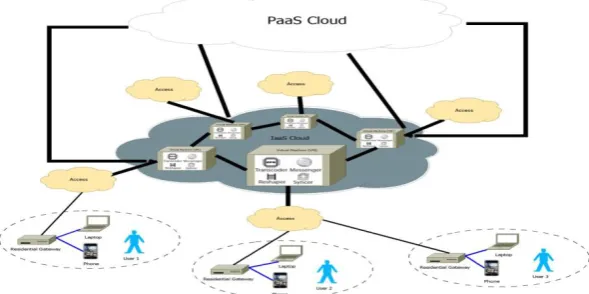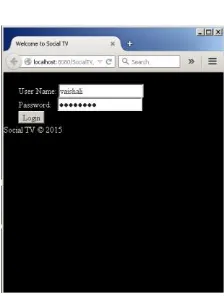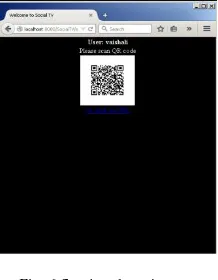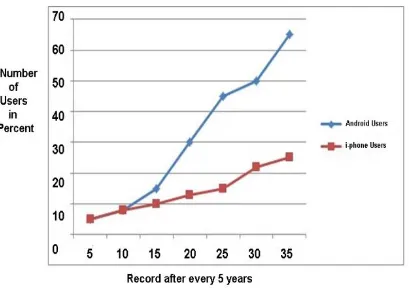ISSN(Online): 2320-9801
ISSN (Print): 2320-9798
International Journal of Innovative Research in Computer
and Communication Engineering
(An ISO 3297: 2007 Certified Organization)
Vol. 3, Issue 7, July 2015
Mobile Cloud Media: A Cloud Centric Media
Platform for End-to-End Workflow and
Layered Service Model
Vaishali A. Deore
1, Prof. D. N. Rewadkar
2PG Student, Dept. of Computer Engineering, RMD Sinhgad School of Engineering, Pune, India 1,
Head, Dept. Information Technology, Govt. Polytechnic Awasari, Pune, India2
ABSTRACT: The growth of usage of mobile phones is increasing in rapid increasing urban & rural population. People like to use most probably a smart phone rather than a simply mobile phone. As the demand of smart phones are increasing with the demands of features like a media player, GPS navigation, a digital camera, as well as features of laptop like Wi-Fi support, Browser support, and also having multiple processor core & gigabyte RAMs. With this peoples are like to use a portable TV on the move, which supports live videos, on-demand videos which we can call it as, user subscribed videos and that gives home like feel on the move. We proposed a Multiscreen Cloud Social TV Service, which provides a user, home like environment, just like sitting at home and enjoying by co-viewing Live videos, on-demand videos and commenting on that by text chat on the move from mobile phone. This service is more beneficial for those peoples who are separated geographically from their family as well as friends. The service uses both PaaS (Platform-as-a-Service) and IaaS (Infrastructure-as-a-Service) cloud services to offer the living-room experience of video watching to a group of different mobile users who can interact socially while sharing the video. To give guarantee of good streaming quality of videos, Virtual Machine (VM) is used in the IaaS cloud for every mobile user individually, which downloads the videos and social exchanges on behalf of the user. VM performs good stream transcoding that matches current connectivity quality of the mobile user. Social interactions among users, in terms of textual chat, and storage of data are handling in PaaS cloud. With this one more feature is supported by this service is, Session throwing. This is done from Big screen (Laptop) to Small screen (Mobile) and vice versa. So that, user can enjoys video watching on the move.
KEYWORDS: Cloud Computing, Mobile Media, Cloud Media, Cloud Centric Media Network, Session Throwing.
I. INTRODUCTION
Cloud Computing refers to many applications, services which runs on distributed network using virtualized resources and accessed common Internet protocols and networking standards [1]. Basically there are two different classes of clouds, which are based on deployment model and service model. Deployment model tells us that when and where and for what purpose the cloud is located. And also it includes Private cloud, Public cloud, combination of both clouds i.e. Hybrid cloud, and Community cloud models into it.
Service model describe the type of service which is offered by service provider. The well-known service models are Software-as-a-Service, Platform-as-a-Service, and Infrastructure-as-a-Service. Cloud Computing gives a service to the user that, pay-as-you-go, infinitely scalable, and also universally available system.
The word „cloud‟ makes reference to the two important concepts i.e. Virtualization & Abstraction. In the Abstraction cloud computing it abstracts the details of overall system implementation from both user and developer. Basically in the cloud, the applications which runs on physical system that are not specified, as well as data which is stored in some locations are also unknown, administration of system is outsourced to others, and access by user is ubiquitous.
ISSN(Online): 2320-9801
ISSN (Print): 2320-9798
International Journal of Innovative Research in Computer
and Communication Engineering
(An ISO 3297: 2007 Certified Organization)
Vol. 3, Issue 7, July 2015
A. Cloud Mobile Media
Cloud Mobile Media provides rich media services such as generate the process, edit the process, search media contents like images, video, audio, graphics and so on. In this cloud mobile media paradigm, users can able to store the multimedia applications as well as able to process the applications in a distributed manner. This avoids the installation of media application software on user‟s computer or mobile and also releaving from maintenance and upgrade of software and also saves the battery power of mobile.
B. Layered Service Models
Cloud Computing has basically three layered service model, they are as follows:
Infrastructure-as-a-Service
It provides basically the virtual storages, virtual machines, virtual infrastructure, and many other hardware assets as a resource that most of the clients are required.
Platform-as-a-Service
It provides services, Operating systems, transactions, virtual machines, applications, services, development frameworks, and control structures.
Software-as-a-Service
It is a complete operating environment with many applications, user interface & the management.
C. Cloud Centric Media Platform
Cloud Centric Media Platform is a paradigm which allows user to run the media related files. Such as, text writing or chatting, watching videos without use of any plug-ins, surfing on internet, online shopping, etc.
D. End-to-End workflow
End-to-End workflow means providing service, from Source to Destination. In this there are three main digital media contents included they are,
Content Provider
Content Provider is responsible for creating media contents that are used for distribution and consumption such as Professionals who probably generate media contents with their cameras, or internet users who capture images or videos by their mobile devices.
Media Cloud Service Provider
It is used to collect the media related data and then it stores it into the cloud.
Content Consumer
Content Consumer is the user, who watches the videos on different media devices such as, TV, Laptops, Computers, Mobile phones, Tablet, etc.
II. RELATED WORK
From many years ago there are a number of mobile social TV systems have been implemented, and design with both hardware and software advances in mobile devices. J. Santos et al. in [2] bring the system into living room experience to small screens on the move. But in their research they focus more on barrier clearance, which occurs in television network and mobile network than exploring the demand of social interactions among mobile users.
Later, L. Trappeniners et al. in [3] try to add rich social interactions into the TV, but their design is limited to traditional broadcast channels.
Chang Wen Chen et al. in [4] states about the Multiscreen mobile social TV application, in that they present a application, which supports all the features of media such as, watching live as well as on demand videos, text chatting with friends, and session throwing from one screen to another.
ISSN(Online): 2320-9801
ISSN (Print): 2320-9798
International Journal of Innovative Research in Computer
and Communication Engineering
(An ISO 3297: 2007 Certified Organization)
Vol. 3, Issue 7, July 2015
application. The difference is that, in their model they use a “VMSurrogate” i.e. Virtual Machine Surrogate, which downloads the video and social exchanges on behalf of user and session throwing is not implemented in their design.
Han Hu et.al. in [6] states about, “Toward Multiscreen Social TV with Geolocation Aware Social Sense”. In that they present a model of Large-Scale Geosocial Multimedia network. They state that, they are currently building a unified Big Data platform for social TV analytics. Such a platform integrates several components to facilitate social media analysis, including a social media crawler, Hadoop, Storm, and other natural language processing tools. It aims to benefit stakeholders in the traditional TV ecosystem.
Yichao Jin et al. in [7] states about the Minimizing Monetary Cost via Cloud Clone Migration in Multi-screen Cloud Social TV System in that, they investigates the problem of cloud-clone migration for the multi-screen social TV application, & minimizing its monetary cost. When user switches from one screen to another, at that time this problem arise.
Christopher Kraussal et al. in [8] states about Enriched Personalized Multiscreen content for social connected TV. In that they present a two screen framework mode, in which first screen is for social TV platform, it will bring attractive new application & content concepts to the TV by making use of personalization and recommendation technologies, integrated web-based services, etc. Second screen conceptually demonstrate technical solutions, innovative use cases, and new business opportunities.
Compared to these prior work and systems, we target at a generic portable Multiscreen Cloud Mobile Social TV Service, which offers features like co-viewing experiences among family members and friends over geographically separations through mobile device on the move.
III. PROBLEM STATEMENT
Peoples like to spend time together with their friends and family by enjoying co-viewing live or on-demand videos. This is not possible for all. Most probably for those peoples, who are separated geographically from their family as well as friends. Also with that, watching video on one screen, watching TV on other screen, & chatting on some other screen, makes it difficult to manage all these things at a time
.
IV. PROPOSED SYSTEM
In this paper, we are presenting a Multiscreen Cloud Mobile Social TV service, which gives the user a home like environment on the move. It integrates videos from different sources into one screen and then transcoding and reshaping according to the specifications of users device. Because of this, it gives enjoyment, just like sitting at home with family members and friends, watching live videos together and enjoying a co-viewing experience by commenting on videos in one screen.
In Multiscreen Cloud Mobile Social TV service, user can import a live or on-demand video to watch from any streaming site, invite their friends to watch video concurrently and chat with their friends while enjoying the video. User can able to do text chat with their friends and family in a group on a single screen. There is no need of plug-in to watch the video. It therefore blends viewing experience and social awareness among friends and family members on the go.
A. System Architecture
As our Multiscreen Mobile Social service provides two major functionalities for users are: 1. Universal Streaming
A user can able to watch live or on-demand videos from any source, with encoded format and rates for the device each time.
2. Co-viewing with social exchanges.
ISSN(Online): 2320-9801
ISSN (Print): 2320-9798
International Journal of Innovative Research in Computer
and Communication Engineering
(An ISO 3297: 2007 Certified Organization)
Vol. 3, Issue 7, July 2015
The detailed architecture of Multi Screen Cloud Mobile Social TV service is as follows:
Fig. 1 A System Architecture for Multiscreen Cloud Mobile Social TV service
Fig.1. gives an overview of Multiscreen Cloud Mobile Social TV service. In that VM is the Virtual Machine which is created for every online user in Infrastructure-as-a-Service cloud. The VM acts as a mediator between mobile device as well as video sources. It provides transcoding services and also segmenting the streaming traffic for burst transmission to the user. Besides, they are also responsible for handling frequently exchanged social messages among their corresponding friends and family members in a timely and efficient manner, and also it protects mobile devices from unnecessary traffic and enabling battery efficient, spontaneous social interactions. The VM exchanges social messages via a back-end PaaS cloud, which adds scalability and robustness to the system. There is a residential gateway server in the system that keeps track of participating users in the service, which can be implemented by a standalone server or Virtual Machines in the IaaS cloud.
Also with that Session throwing is implemented. User can switch from Laptop to Mobile in between session just by scanning the QR code from mobile with laptop. His mobile and laptop gets authenticated & then a synchronized image will be displayed on his mobile phone screen. User indicates its interest in transferring the sessions on chat and content viewing with him. Finally the user will flip his phone from laptop & session will continue from laptop to mobile. And also user can switch from mobile to laptop without interrupting the service with the same procedure as did for laptop to mobile. This can be done from any device, just need of 3G network and a support of browser such as Mozilla, Chrome, etc.
There are following some major sub-functional modules of architecture are as follows:
Messenger
It is the client side of the cloud, residing in each VM in the IaaS cloud. The messenger captures the data from cloud on the behalf of user and pre-processes the data into a plain text format at a low frequency. Then the plain texts are asynchronously delivered to a user through VM in a friendly manner. Also it manages the user‟s invitation and chat messages to other users via the data store in the cloud.
Transcoder
It resides in the VM, and thinks how to encode the video stream from the video source in the proper bit rate, proper format, and proper dimensions. It encodes the video streaming properly before delivering to the user. The encoded video stream is always proper and plays on every user‟s device.
Reshaper
The Reshaper receives the transcoded video stream, then divides the stream into the segments & then sends each segment to the user on demand basis. The amount of data in each burst size is decided according to the 3G technologies implemented by the corresponding carrier.
Syncer.
ISSN(Online): 2320-9801
ISSN (Print): 2320-9798
International Journal of Innovative Research in Computer
and Communication Engineering
(An ISO 3297: 2007 Certified Organization)
Vol. 3, Issue 7, July 2015
the current playback progress of the session host and instructs its mobile user to adjust its playback position.
Mobile client
Mobile client is not required to install on mobile. As every mobile supports Chrome, Mozilla, etc. browsers, that supports HTTP live streaming protocols [10].
Gateway
Gateway provides the authentication services to the user & also stores information of currently available VMs in the IaaS cloud. Moreover, VM also stores each user‟s friendlist in a plain text format.
B. System Logic Block Diagram
Fig. 2 System Block Diagram
Initially when the user gets login into the system successfully, he is assigned a Virtual Machine service through Virtual Machine pool. Then the user is automatically redirected to the assigned VM, and welcomed by a portal page. After user login, the portal collects the device configuration information by user agent header values, and this information will be sent to its VM for decision making of the video encoding formats.
Then the user can enter the URL of the video or live broadcast he wishes to watch, and then the VM downloads the stream on the user‟s behalf, transcodes and sends properly encoded segments to the user. From VM to the mobile device, the video stream is divided into multiple segments, with a playlist file giving the indices. When the mobile user subscribes to a video, the playlist is first downloaded and individual segments are requested by the user. Then user can start to play the stream as soon as the first segment is received.
When user clicks on throw session, a synchronized image will generate for current session. We can call it as a QR code. When user scan that synchronized image from phone, immediately session will throw on phone. And then the same is continuing on phone.
C. Implementation Strategy
ISSN(Online): 2320-9801
ISSN (Print): 2320-9798
International Journal of Innovative Research in Computer
and Communication Engineering
(An ISO 3297: 2007 Certified Organization)
Vol. 3, Issue 7, July 2015
Fig. 3 Module Diagram
VM instance is responsible to manage the transcoded & reshaped video stream. It also manages the exchange of messages with users. When user switches on session throwing feature, the QR code is generated for current session and a session throwing takes place from one screen to another.
Google App Engine (GAE) and Amazon EC2 clouds are the two most widely used public PaaS and IaaS cloud platforms. We are using GAE [11] as a PaaS cloud, which provides rich services on top of Google‟s data centers and enables rapid deployment of JAVA based applications. GAE is a platform for implementing our social cloud, which handles large volumes of messages. Also GAE imposes many constraints on application deployment, such as lack of support for multithreading, file storage, etc., which may hold both computation-intensive jobs and content distribution applications.
Amazon EC2 [12] is a representative IaaS cloud, offering raw hardware resources including CPU, storage, and networks to users. Comparing to various common PaaS cloud, EC2 is an appropriate platform for computation intensive tasks in our service, i.e., the VM carryout. All the VM are provisioned from Amazon EC2 web services and tracked by the gateway. We propose to implement all the video processing related tasks using ANSI C, to guarantee the good performance of video streaming.
We install mpeg together with codec as the groundsill library [12] to develop the transcoding, segmentation and reshaping modules on the VM surrogates. We are also using Tomcat web server (version 7.0) to serve as a Servlet container and a file server on each surrogate. Both mpeg and Tomcat are open source projects. Once a VM receives a video subscription request from the user, then it downloads the video from the URL source, and processes the video stream by transcoding and segmentation, based on the collected device configurations by the portal.
V. RESULTS
ISSN(Online): 2320-9801
ISSN (Print): 2320-9798
International Journal of Innovative Research in Computer
and Communication Engineering
(An ISO 3297: 2007 Certified Organization)
Vol. 3, Issue 7, July 2015
The above fig. shows the client User Interface. It is a login page, where user can enter a username and password to get log in into the service.
Fig. 5 Sync Video session
In the above figure, two users are watching same video in a same session. One is the host and another is the subscriber. With this they both can chat with each other in between the video playing session.
Fig. 6 Session throwing
In the above fig., QR code has been generated. This is generated when user wants to do session throwing. Just by clicking on a button of throw session, a QR code will generate for current session. After scanning this QR code from any device, the same session will continue from that device.
VI. CONCLUSION
In this paper we proposed a Multiscreen Cloud Social TV service, which gives the user feel like home environment while watching together live or on-demand videos with friends and family members, also text chat with them, which gives user a feel, just like sitting at home and watching videos with friends & family members in a same session.
This service introduces a generic and portable mobile social TV framework, which makes use of both IaaS cloud and PaaS cloud. This TV framework provides good transcoding services for most platforms under various network conditions and also it supports for co-viewing experiences through timely chat exchanges among the viewing users. By employing one VM for each user, we can achieve ultimate scalability of the system.
Amazon EC2 instances serves as the mobile users VM and GAE as the social cloud to handle the large volumes of social cloud to handle the large volumes of social message exchanges.
ISSN(Online): 2320-9801
ISSN (Print): 2320-9798
International Journal of Innovative Research in Computer
and Communication Engineering
(An ISO 3297: 2007 Certified Organization)
Vol. 3, Issue 7, July 2015
for Android users, because according to survey of mobile user market in India, there are 90% peoples using Android phone rather than i-phone. So, it is believe that, this service will creates scope in the market.
Fig. 7 Graphical Analysis
The above graph shows the number of increasing users for android phone, as compare to i-phone. The proposed system is implemented for android phone. After surveying in mobile market of India, it is concluded that android users are more than i-phone user. It known to many that i-phone has many more features and functionality better than android, but its cost is not affordable to all mobile users. That‟s why user chooses for android phones. And after launching this service for android phones, it creates boom in the android market.
The above graph shows the number of users for android and i-phone in India. It is a survey of every 5 years. It seen that, every five year the percentile of android users is increasing as compare to i-phone.
REFERENCES
1. Barrie Sosinsky, “Cloud Computing Bible”, at Wiley India Pvt. Ltd.
2. J. Santos, D. Gomes, S. Sargento, R. L. Aguiar, N. Baker, M. Zafar, and A. Ikram, “Multicast/broadcast network convergence in next generation mobile networks,” Science Direct, Comput. Netw., vol. 52, pp. 228–247, January 2008.
3. T. Coppens, L. Trappeniners, and M. Godon, “AmigoTV: towards a social TV experience,” in Proc. of EuroITV, 2004.
4. Yonggang Wen, Xiaoqing Zhu, Joel J. P. C. Rodrigues, and Chang Wen Chen, “Cloud Mobile Media: Reflections and Outlook”, IEEE TRANSACTIONS ON MULTIMEDIA, VOL. 16, NO. 4, JUNE 2014, Pages: 885 - 902, DOI: 10.1109/TMM.2014.2315596.
5. Yu Wu , Zhizhong Zhang, Chuan Wu†, Zongpeng Li, Francis C.M, “CloudMoV: Cloud-based Mobile Social TV”, IEEE Transactions on Multimedia, 2013, Volume: 15, Issue: 4, Pages: 821 - 832, DOI: 10.1109/TMM.2013.2240670.
6. Han Hu, YonggangWen, Huanbo Luan and Tat-Seng Chua, Xuelong Li, “Toward Multiscreen Social TV with Geolocation Aware Social Sense”, MultiMedia, IEEE, 2014, Volume: 21, Issue: 3, Pages: 10 - 19, DOI: 10.1109/MMUL.2014.2
7. Yichao Jin and Yonggang Wen, Han Hu, “Minimizing Monetary Cost via Cloud Clone Migration in Multi-screen Cloud Social TV System”, Global Communications Conference (GLOBECOM), 2013 IEEE 2013, Pages: 1747 - 1752, DOI: 10.1109/GLOCOM.2013.6831326.
8. Christopher Kraussal, Robert Seeliger, Anette Wilson, Stefan Arbanowski, “Enriched Personalized Multiscreen content for social connected TV”, CC-BY 4.0 license: http://creativecommons.org/licenses/by/4.0/ TVX‟14, June 25 – June 27, 2014, Newcastle, UK. DOI.10.6084/m9.figshare.1032590.
9. Judith Hurwitz, Robin Bloor, Marcia Kaufman and Fern Halper, “Cloud Computing for DUMMIES”, by Wiley Brand. 10. HTTP Live Streaming, http://tools.ietf.org/html/draft-pantos-http-livestreaming-01.
11. Google App Engine, http://appengine.google.com/. 12. FFmpeg, http://ffmpeg.org/.
BIOGRAPHY
Vaishali Arun Deoreis a PG student in the Computer Engineering Department, RMD Sinhgad School of Engineering, Savitribai Phule Pune University. She received Bachelor of Computer Engineering (B.E) degree in 2012 from Mumbai University, Mumbai, MS, India. Her research interests are Cloud Computing.




